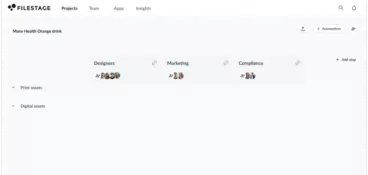When was the last time you took a hard look at the processes that make up your own and your team’s workflows in marketing?
The reality is that inefficiencies creep into our work habits over time, resulting in slower progress and added frustration.
The question is, how much faster could you get work done with a better workflow?
To help you answer that question, we’ve put together seven marketing workflows that will help you streamline your marketing activities:
What is a marketing workflow?
Marketing workflows outline the sequence of steps your team will take as they’re completing a particular marketing task.
These workflows are important because they help you streamline the way your team works. Therefore, you can improve the satisfaction, efficiency, and overall quality of your entire team.
Marketing workflows come in all shapes and sizes. The magnitude depends on the task at hand, your industry, the profiles in your marketing department, and other factors.
The most successful workflows share the following features:
Logical
Workflows will help your team establish a consensus about the information they need to be able to work predictably. For this reason, it’s important to make sure your workflows are logical and easy to understand.
Visible
Workflows are most effective when every member of your team understands where they can find them and how to use them. To ensure this effectiveness, use the following tips:
- Introduce workflows during the onboarding of a new team member.
- Share updates by using a consistent style and channel.
- As necessary, cover workflows in your knowledge base.
Iterative
Eventually, workflows change. For example, you might introduce a new tool or discover a new way to increase efficiency. So it’s important to make sure your workflows can be adjusted and tweaked accordingly.
Manage every approval in one place
Request content approval without sending a single email with Filestage.
Why should you map and optimize your marketing workflows?
It’s virtually impossible to overstate the importance of marketing workflows. These tools are useful for a wide variety of reasons. Here’s a closer look at the reasons why you should pay close attention to your workflows.
Drive consensus on your team
Marketing workflows harmonize your team and ensure that everyone reads from the same script. This protocol will help you boost efficiency, so you can take your collaboration to the next level.
Improve the quality of your output
These workflows give marketing teams the instructions and guidance they need to create perfect outputs every time, which helps teams work in a deliberate, skillful way that encourages close collaboration. In other words, your clients will be happier with your results.
Incorporate new efficiencies
Eventually, marketing workflows can be adjusted to incorporate new techniques and strategies. For instance, you realize your blog posts are much better when your editor Tomas is the last person to review them. So you decide to adjust your workflow, in order to make sure he completes the final step.
Workflows give you the ability to act on your learning, so you can provide a predictable method to constantly improve the way you work.
Elevate the profitability of your projects
To help reduce the amount of time spent on your projects, marketing processes elevate transparency and boost collaboration across the board.
In other words, your team can do more in less time. And ultimately, the profitability of your marketing projects will receive a boost.
Manage every approval in one place
Request content approval without sending a single email with Filestage.
Marketing workflow examples with templates
Let’s take a look at some examples, including marketing workflow templates that you can start using today. Then you can get a better idea of what they look like and how they can drive value in your team.
1. Marketing workflow templates for collaborating with an agency
When it comes to marketing workflows, marketing operations managers who work in corporate companies have particularly tough jobs. These professionals have to make the most of internal workflows while they coordinate external stakeholders.
Luckily, marketing workflow templates can help marketing operation managers spin up a new project with an agency.
Here’s an example of an effective marketing workflow template:
1. Go through your agency’s onboarding process
This process is important because it provides the foundations for a productive, lasting relationship. During this step, you’ll want to take care of the following:
- Clear up specifics about finances and contracts.
- Provide your information with as much information as possible about your project and your company
- Have a kickoff event.
2. Sign a project proposal
Depending on your preferences, you may (or may not) have to create a project proposal. Especially if you’re starting to collaborate with a new agency, it makes sense to use a project proposal. If you feel it’s needed, ask your agency to prepare a detailed project proposal.
This document should provide all of the important specifics about your agency’s team, as well as vital information about their business. It should make sure why the chosen agency does a better job than any other agency.
3. Work together on your creative brief
Now, it’s time to put together the creative brief. This document lays the foundations that will help both of you plan your creative deliverables. This valuable blueprint explores the ins and outs of the project. So it’s critical for each project member to understand it.
Here’s a comprehensive guide (and template) on how to create a creative brief.
You’ll also find that this document is very valuable because it will help guide your project as you keep going. If you feel like you’re getting confused or straying off-course, you can always refer back to your creative brief.
4. Define the project scope
A scope statement will help you and your agency agree on the exact accomplishments that need to occur as part of the project. In other words, it’s the perfect place to start and sets a binding working agreement.
Your agency can use the creative brief to craft the project scope statement. This exercise will prove that they really understand what you need to do in order to be successful.
If you want to learn more, read our piece about how to create a robust project scope statement.
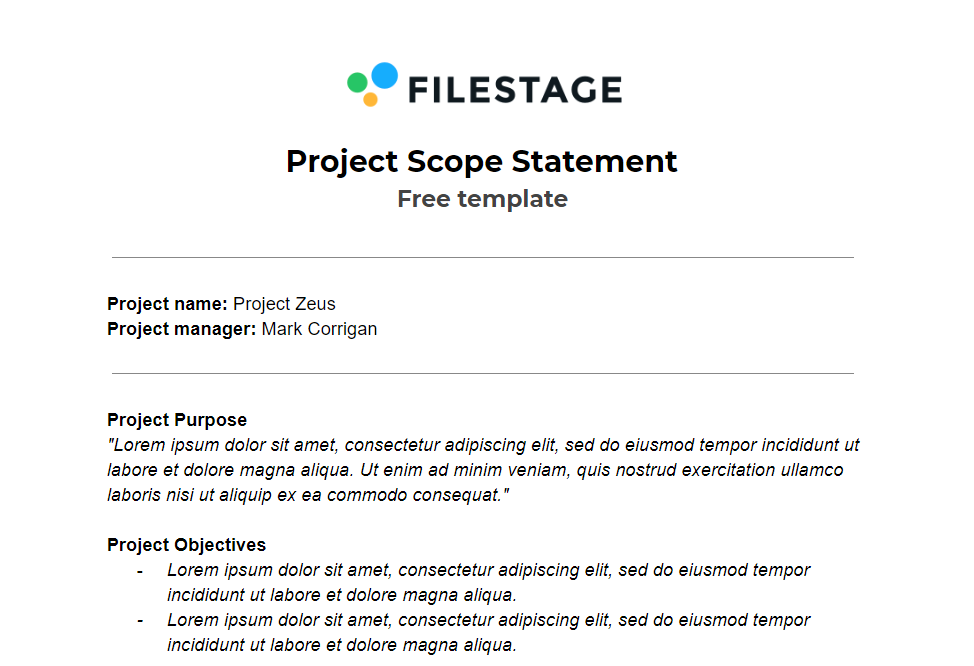
5. Agree on a project timeline
With this timeline, you can make sure that your project is transparent and organized. This timeline tracks exactly how your project will come together, which will help you agree on a defined plan your agency will stick to.
The best project timelines help you reveal dependencies and preemptively tackle potential blockers. So it’s certainly worth the large investment of time required to create a robust, detailed project timeline. This commitment could save your project in the future.
For more guidance, read our piece on how to create an effective project timeline and get access to five free marketing workflow templates for project timelines.
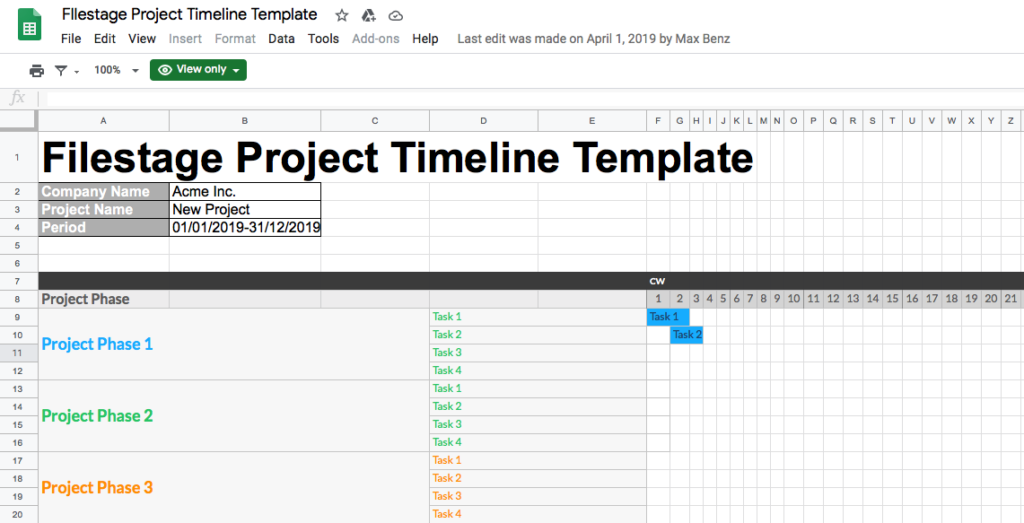
6. Let your agency start working
Now that you’ve laid all the groundwork, it’s time for your agency to start working its magic. As a marketing operations manager, you should offer support as necessary, in order to ensure that everybody is able to do their best work possible.
You should also act as a liaison between your agency and the rest of your team. Then you can make sure that everybody is informed, and that communication flows freely. So you should quickly respond to potential issues, and make sure that tasks are reviewed according to the plan you created.
7. Get into the review and approval process
The content review and approval process is often complex. So you need to establish a good way to provide and receive feedback in an efficient, clear way. This tactic will ensure that your agency has the accurate feedback they need to move forward.
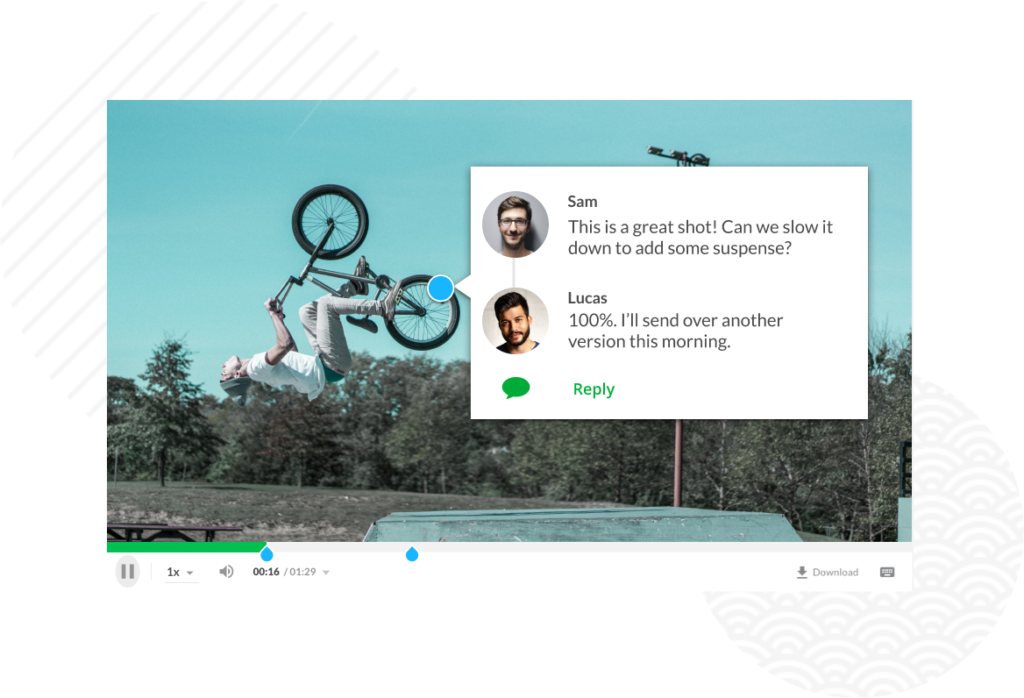
One way to achieve this involves using Filestage. Our tool gives your internal and external stakeholders (including your agency) the ability to leave clear and in-context feedback that will help your project succeed.
8. Sign-off final deliverables and wrap up your project
After you’ve finally approved all of the pending deliverables, it’s time to wrap up the project.
After your materials have been delivered, the project will start moving toward its conclusion. To make sure you’ve taken care of all of your loose ends, you should use a project completion checklist.
2. Marketing automation workflow templates to score your leads
Marketing is a tough field that’s filled with complex and time-consuming tasks. So you’ll want to automate as many tasks as possible with sample marketing workflow templates.
Here’s an example that will help you rate your leads.
1. Collect your leads
First things first: You’ll want to polish and launch your lead generation program. To help you capture leads from a range of sources, this program should be optimized.
But this program is often put together as a joint initiative between sales and marketing. Like CRM, this approach often requires the use of a range of marketing workflow tools and a platform that offers functionality to lead management.
2. Understand your lead behavior and attribute scores.
Now you have an understanding of where your leads come from, and how they tend to behave. So you can start monitoring their intent. What do they want from your business?
You should monitor the behavior of your leads. Then you should think about ways you can create automated lead nurturing programs that will drive value and convert your leads into prospects.
You should try to see things from your lead’s perspective. You need to be able to predict his or her behavior. When will he or she want more information? Use this insight to attribute values to certain actions and classify your leads into groups.
3. Create and launch automated lead nurturing programs
Now that you can attribute scores to your leads, you’ll want to think about ways to categorize them, and the actions you should take for each group.
Let’s imagine that you have the following groups:
- Cold: 0-25 points
- Interested: 25-50 points
- Intrigued: 50-75 points
- Warm: 75+
You might want to develop a lead nurturing program for each group.So you decide that the warm group is ready for a call or personal contact. Meanwhile, you should send the interested group links to particular resources.
4. Track results and adjust your strategy
Over time, you should track your lead nurturing process and adjust your strategy accordingly. This constant refinement can tighten each area of your lead nurturing process. Then you can get the best results possible.
3. Social media marketing workflow templates
Social media can easily eat up a lot of time. But with social media workflow templates, you can improve both your efficiency and your results of social media campaigns.
Here’s an example of an effective marketing workflow template:
1. Create content ideas
To begin this workflow, your social media managers will need to generate content ideas—with the help of the rest of your team. These ideas should try to fulfill the goals of your social media marketing. They could involve marketing campaigns or individual posts. At this stage, you should value all the suggestions and creative input you receive.
2. Choose your ideas
Now that you’ve put your ideas together, your social media manager should select the ones that will most effectively fulfill their goals. Then they should be fleshed out and checked for viability.
3. Determine your schedule
With your new, ideas in hand, it’s time for the project manager to think about the practical ways everything is going to fit together. And your social media manager should start putting together a tentative schedule for the posts across platforms.
4. Create your copy
At this stage, you’ll have a good concept of your exact needs and the skeleton of your social media schedule. Now it’s time to start working on the posts themselves, which begins with the copy. This practice will help you get your messaging right, and shape the next steps.
5. Work on the design
To determine which visuals are needed, the copywriter should work with the social media manager. Then they should pass their decision on to the design team. At this point, they can work their visual magic and create the necessary graphics or images.
6. Send content to stakeholders for approval
Now that you’ve tied your social media posts together, it’s time to pass them along to your stakeholders for approval. You should think about the best ways to deliver this marketing collateral to them. While some stakeholders prefer a spreadsheet, others may want another format.

7. Make any necessary edits
It’s time for you to respond to feedback. You should be sure to collect accurate, actionable data that can help your team make the right edits without missing anything. At this point, a tool like Filestage can help you create your best work.
8. Handle the specifics
Let’s say your social media manager’s name is Katerina. Now that you’ve finalized the collateral, it’s time for her to work her magic. She should use her preferred platform to schedule posts and take care of the small details that will guarantee success.
9. Take care of reporting
After you’ve dispatched your posts, Katerina should dive into the numbers, in order to pinpoint how her posts have performed. And she should rely on the right tools to help her analyze and strategize the best steps for moving forward.
4. Email marketing workflow
Email marketing is huge and email marketing workflow templates can help you get the most from your email activities.
Here’s an example:
1. Establish the why
The first step in your email marketing workflow should be establishing the rationale behind your email campaign. It’s important for your marketing manager to clearly outline the reason behind this email. Let’s say this manager’s name is Hector. What does he hope to achieve?
2. Determine content needs
Based on the results of the first step, Hector should work alongside the team to establish exactly what’s needed to coordinate an effective email marketing campaign. The components could include your copy, design, landing page, marketing campaign logic, and more.
3. Focus on design
Now it’s time to get down to creating the email itself. When it comes to email, it makes sense to begin with the design. Then you can make sure your message makes a strong visual impact. So your designers should use the right tool to create an attractive, appropriate email design.
4. Create the copy
After the design is ready, it’s time for your copywriter Natalia to craft the email text. She should be conscious of the word count, and try to create messaging that achieves the goals outlined in the first step.
5. Handle the mechanics
With the email ready, it’s time for Hector the marketing manager to take care of the mechanics of the email. For instance, he should work alongside the rest of the team to create a great subject line. He should also make sure that the mechanics are appropriately configured in his chosen tool.
6. Test and review
At this point, it’s important to test and review the email. This step will help the marketing team identify any potential errors or issues. Then they can rectify them further down the line. To spot any potential errors, the email should be tested on numerous accounts and via various devices.
7. Make adjustments
Now it’s time to make any necessary adjustments and edits. And it’s very important to outline detailed, clear feedback. Then your team can efficiently and accurately work without creating more issues than they solve.
8. Send the email
Now that your email is ready, it’s time to dispatch it via your preferred method. You might use an email marketing platform to automate the process and optimize the number of successful deliveries.
9. Take care of reporting
Hector should monitor the performance of the email and track its impact. Moreover, he should compare the results to the goals outlined in the first step, and he should record any learning opportunities.
5. Content marketing workflow templates
Content marketing is the cornerstone of every good marketing strategy. And with content marketing workflow templates you can boost your blog post production and convert more leads.
Here’s a content marketing template that will help you excel at your content marketing strategy:
1. Plan your content
First and foremost, you’ll want to properly plan your content. In other words, you should craft your content marketing goals, including the pieces of content that can help you meet your strategy.
The best content is planned far in advance, and it serves a strategic purpose. So you should plan out every piece and give it an overall structure before you assign it to a writer.
This step is often a collaborative effort between the marketing manager and the person responsible for content creation.
2. Write the content
Now that you’ve mapped out the content, it’s time for your copywriter Natalia to step up to the plate. Your detailed brief will help her focus on creating compelling copy that hits your strategic goals.
You might find that Natalia occasionally needs some assistance, especially a second pair of eyes. Therefore, she should be able to connect with other team members in a way that will enhance the quality of her copy.
3. Edit the text
After the first draft of the blog post is ready, the copywriter can send it along to Tomas the editor. The structure of this step will vary according to your business. For example, you might have multiple copywriters but no editor.
Regardless, it’s important for a second person to through the text and make suggestions about how to clarify it. Since these revisions really can help elevate the quality of the piece, a good editor is worth his weight in gold.
4. Commission graphics
You might find that your blog post needs some images or infographics. So you should create a list of the required graphics and a concise brief for your designers. Then after you pass this brief along to the designers, they’ll be able to create the required imagery.
To ensure your design team delivers a quality piece that will enhance the value of the blog post, they should each have their own design workflows.
5. Proofread the text
Now that the blog post is ready, it’s time for final proofreading. Ideally, multiple people should proofread the piece, in order to find any potential errors.
Small typos and grammatical errors are more common than most people realize. So your copywriter and editor should have a list of the most common issues to watch for. It’s also important for you to align their goals with your writing guidelines.
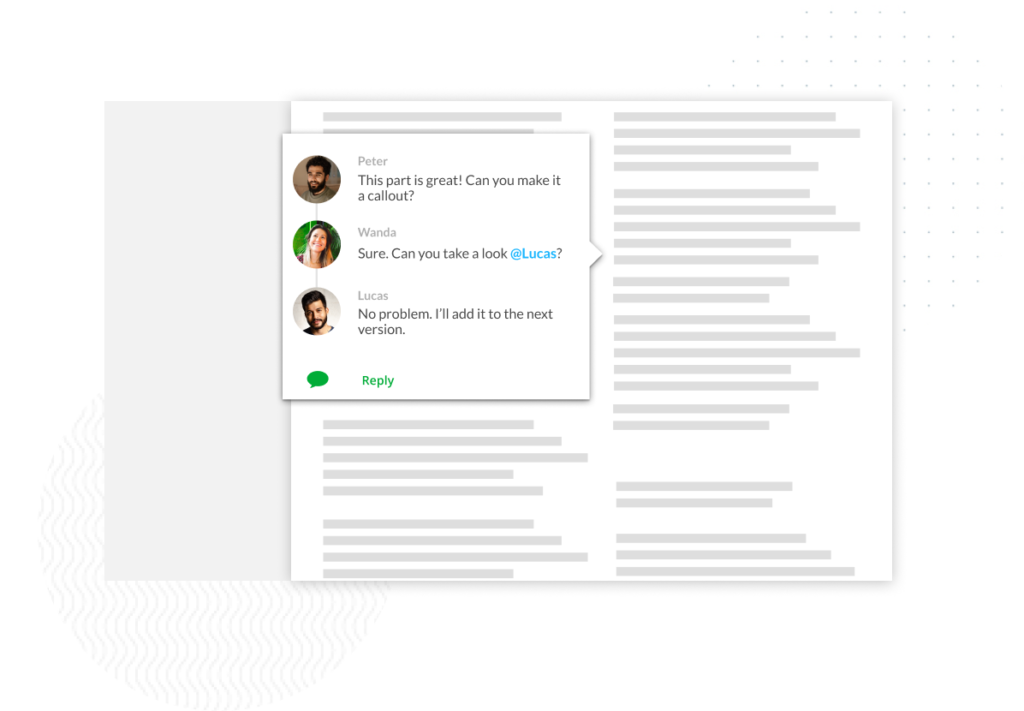
6. Secure approval, publish, and monitor
Your internal and external stakeholders should approve the piece. After you’ve secured approval, it’s time to publish the piece and monitor its progress.
6. SEO marketing workflow tempaltes
Every successful marketing department must understand how to get the most out of SEO.
Here’s one of the SEO marketing workflow templates that will allow you to optimize content more easily.
1. Select your keywords
Before you get down to creating great content that will go viral, you’ll want to perform your keyword research. If you take the time to identify the appropriate keywords, you can provide structure to your content. Then you’ll make sure it has the best chance of ranking well.
A wide range of tools out there can help you identify the keywords you should be using. For instance, SEOmoz offers a suite of tools at cost, but there are free alternatives (e.g., AnswerThePublic).
2. Cover those keywords in your content
After you’ve identified the keywords, it’s time to cover them in your content. You should make sure to follow all of the best-established practices. For instance, you should only use keyword phrases every so often, and you should make sure you don’t engage in keyword stuffing.
Use the phrases organically, and have an SEO professional make sure everything looks okay. He or she will be able to make suggestions and help you get the best results possible.
3. Perform on-page optimization
Now that the post has been written, it’s time for you to take care of the on-page optimization tweaks that can set your blog post up for success. Since there’s a range of things to take care of, you should rely on a quick checklist.
Here’s a common example of the things you’ll want to cover:
- Keyword placement
- Titles and headings
- Meta description
- Alt text and descriptions of images
All of these little tweaks can optimize your content, so you can make sure it’s as effective as possible.
4. Take care of off-page optimization
After your piece has been published, it’s time to take care of various off-page optimization tasks. Generally, this step involves building backlinks and giving your piece the level of visibility it deserves.
For example, you’ll want to make sure you submit everything in the appropriate forums, and that you share the post on all of your social media channels.
5. Assess the way your content ranks
Lars is the SEO professional on your imaginary team. He should make sure he carefully monitors the performance of your piece throughout the project. This effort will help your team identify all issues or opportunities.
Do you understand which of your pieces work well? Do you know how they’re different? If so, this effort will help you make the right decisions in the future. As a marketer, it’s very important for you to rely on research to make your decisions.
6. Tweak your content
To determine whether a piece is reaching its full potential, you should dig into the data you’ve gathered from your feedback. If you suspect that a piece isn’t performing as well as it should be, it’s time to make some tweaks.
You might decide to adjust the content itself or make some slight adjustments to the meta-information. If the foundations of the piece are strong, It’s important to make sure you don’t abandon it if it performs poorly. Remember, you can always make changes.
Five best practices for marketing workflow management
Looking for the best practice tips to elevate your marketing workflow management? Here are five commandments to follow at all times.
1. Know when to make updates to your workflow
Since small changes and updates might have a big impact on your marketing workflow, it’s important to monitor its performance and suitability. In other words, your workflow may eventually create more problems than it solves.
So keep an ear to the ground. Your team members will be the first ones to realize if a particular part of your workflow is no longer appropriate or logical. Therefore, you should accept their feedback and make the necessary adjustments.
In the following circumstances, you might have to adjust your workflow:
- A change in tools
- A change of personnel
- A new internal policy
- The results you achieve
2. Guide your team
It’s important for you to take the reins. Then you can make sure your team understands why the marketing workflows exist, and how to get the most out of them. You should also be able to justify your workflows and answer any questions about them.
If you’re going to effectively guide your team, it’s important to achieve the following:
- Make your workflows visible.
- Present the appropriate workflows to your team.
- Communicate any changes to your workflow.
- Listen to your team’s feedback.
3. Keep things simple
The most effective workflows are simple to follow. They help every member of the team understand their roles and responsibilities, as well as the way everything fits together.
When you create a workflow, you should do your best to keep things simple. Work with a critical eye, and think about the ways the other members of your team are going to interpret your workflow.
You should also ask your team members to review the workflow and provide their feedback before it’s finalized and circulated. This process can refine your marketing workflow and make it a practical tool your team can use.
4. Nail the beginning of your workflow
Every part of your workflow is important, and the steps should naturally flow into one another. But it’s especially important to make sure that the beginning of your workflow is as clear and detailed as possible.
The beginning of your marketing workflow is the foundation for the rest of your process. So if your workflow is going to succeed, your first steps should include all of the appropriate details and rationale.
Frequently, you’ll want to define the following during the first step of each workflow:
- Why the project is taking place.
- What you hope to achieve.
- How you’re going to measure success.
- How you’re going to achieve your goals.
5. Control your workflow. Don’t let it control you.
If you create your workflow well, it can become a very useful tool for you and your team. It’s very important for you to remember that a workflow is a tool. So you should do your best to control it, not the other way around.
Some marketing managers stick too closely to their workflows, which makes them reject or ignore new opportunities and work methods. It also means that they might frustrate their team members and reduce their satisfaction levels.
Even though adherence to your workflow is very important, it’s also important to remain flexible and adjust your process as needed.
Marketing workflow tools
If you’re going to create robust marketing processes, you have to use the right tools. Here’s a look at six of the best marketing workflow software.
1. Filestage – marketing workflow software for feedback and approval management
Filestage is the perfect tool for optimizing your marketing workflow. The online proofing platform helps marketing operations managers and their teams collect clear and precise feedback from both internal and external stakeholders (such as partners).
This tool requires no specialized knowledge, and it’s very easy to access and use. In other words, your stakeholders won’t encounter any problems when they try to access it. So your team can get feedback easily and fast.
Filestage also helps with task management. That means you’ll never miss an important comment or note, so you can confidently move through your workflow to create amazing digital projects—every single time.
2. HubSpot – marketing workflow tool for campaign automation

HubSpot offers a suite of powerful tools that will help sales and marketing teams grow. This platform opens up a range of robust functionality for marketing automation that can help you scale your growth and spend less time on repetitive marketing tasks.
This tool also gives you the ability to automate a wide range of tasks. For instance, it can help your marketing team create stunning personalized emails, or give them a helping hand when they’re creating landing pages.
It also integrates with the free HubSpot CRM, which gives you the ability to see how your marketing activities will boost your bottom line.
3. Hootsuite – marketing workflow tool for social media content

Hootsuite is one of the world’s most popular platforms for social media marketing workflow management. It gives your social media professionals the opportunity to master this workflow and manage all of your social media on one single platform.
This tool’s dashboard allows you to schedule posts for all of the key social media platforms. And advanced features help you find the best content to publish, and they simplify the scheduling of that content.
Hootsuite also offers powerful social analytics. The reporting features give you the power to collate data from across platforms, and export that data into easy-to-create reports.
4. Mailchimp – marketing workflow software for email marketing

MailChimp started out as an email marketing platform. While its functionality has expanded, it’s still a great choice for mastering your email marketing campaigns.
This tool offers a range of pre-built email templates and intuitive design tools that make it easy to create stunning emails. But it isn’t just about aesthetics. It also offers further automation and reporting opportunities.
Marketing professionals will find that Mailchimp can provide sophisticated capabilities for reporting and analytics. These features can help your team members optimize their email marketing workflow and achieve their objectives.
5. Storychief – marketing workflow software for blog content
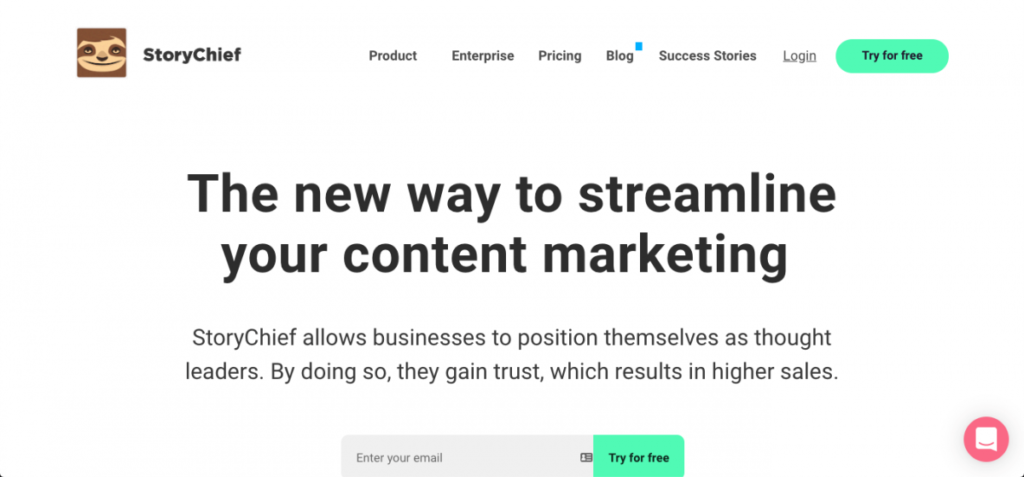
With Storychief, your team can create and distribute more quality content than ever before. This tool achieves this goal by offering a one-stop-shop for all your content marketing needs.
It also augments a wide range of key marketing tasks, and it makes it easy to publish content across various channels. For instance, it offers your content professionals sophisticated analytics that will guide their decisions.
The inclusion of a content calendar makes it easy to plan content and stick to your established workflow. An SEO assistant can also help you at various stages of a typical content marketing workflow.
6. Ahrefs – marketing workflow tool for SEO

Ahrefs combines a wide range of sophisticated SEO tools that give marketing professionals the ability to take their activities to new heights. Specifically, it can help with auditing, competitor research, backlinks, and more.
These tools can give you a helping hand at various stages of your SEO workflow and elevate your results. They’re also ordered in a logical way that will help you shape your workflow.
You’ll find that Ahrefs can cover most of your bases, and it will enhance the quality of your overall output.
Conclusion
If you know how to leverage the power of workflows, you can generate a more productive, inspired team. We hope this post has been helpful for you. If you’d like to learn more about how Filestage can help you improve your marketing workflow, request your free demo today.




